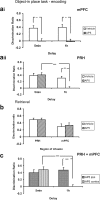NMDA receptor plasticity in the perirhinal and prefrontal cortices is crucial for the acquisition of long-term object-in-place associative memory
- PMID: 18337414
- PMCID: PMC6670687
- DOI: 10.1523/JNEUROSCI.4447-07.2008
NMDA receptor plasticity in the perirhinal and prefrontal cortices is crucial for the acquisition of long-term object-in-place associative memory
Abstract
A key process for recognition memory is the formation of associations between an object and the place in which it was encountered, a process that has been shown to require the perirhinal (PRH) and medial prefrontal (mPFC) cortices. Here we demonstrate, for the first time, the importance of glutamatergic neurotransmission, within the PRH and mPFC, for object-in-place associative recognition memory. Unilateral blockade of AMPA receptors (by CNQX) in the PRH and mPFC in opposite hemispheres impaired an object-in-place task in rats, confirming that these cortical regions operate within a neural network for object-in-place recognition memory. Intra-mPFC infusions of AP5 (NMDA receptor antagonist) impaired short-term memory and the acquisition of long-term memory, but had no effect on retrieval. AP5 infusions into the PRH disrupted acquisition of long-term memory, but not short-term memory or retrieval. Significantly, crossed AP5 infusions into both the PRH and mPFC disrupted acquisition of long-term memory but were without effect on short-term memory. Finally a unilateral infusion of the selective kainate (GLU(K5)) receptor antagonist UBP302 [(S)-1-(2-amino-2-carboxyethyl)-3-(2-carboxybenzyl)pyrimidine-2,4-dione] into the PRH combined with a unilateral infusion of AP5 into the contralateral mPFC significantly impaired short-term object-in-place associative memory. These data show that the PRH and mPFC make distinct contributions to object-in-place associative memory and that the encoding of long-term but not short-term memory requires concurrent NMDA receptor activation in both cortical regions. In contrast, short-term object-in-place memory appears to be dependent on kainate receptor activation in the PRH and NMDA receptor activation in the mPFC.
Figures






References
-
- Barker GRI, Warburton EC, Koder T, Dolman NP, More JCA, Aggleton JP, Bashir ZI, Auberson YP, Jane DE, Brown MW. The different effects on recognition memory of perirhinal kainate and NMDA glutamate receptor antagonism: implications for underlying plasticity mechanisms. J Neurosci. 2006;26:3561–3566. - PMC - PubMed
-
- Browning P, Easton A, Buckley M, Gaffan D. The role of prefrontal cortex in object-in-place learning in monkeys. Eur J Neurosci. 2005;22:3281–3291. - PubMed
-
- Bussey T, Duck J, Muir J, Aggleton J. Distinct patterns of behavioural impairments resulting from fornix transection or neurotoxic lesions of the perirhinal and postrhinal cortices in the rat. Behav Brain Res. 2000;111:187–202. - PubMed
Publication types
MeSH terms
Substances
Grants and funding
LinkOut - more resources
Full Text Sources
Medical
Research Materials
